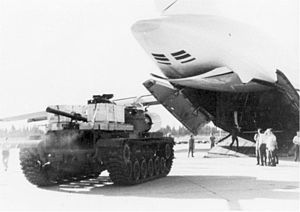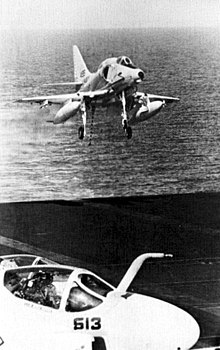Operation Nickel Grass

Operation Nickel Grass was the codename for a strategic airlift conducted by the United States to deliver weapons and supplies to Israel during the 1973 Arab–Israeli War. Between 14 October and 14 November of that year, the Military Airlift Command of the United States Air Force shipped approximately 22,325 tons of supplies, including tanks, artillery, and ammunition, in multiple flights of C-141 Starlifters and C-5 Galaxys.[1][2]: 88 This initiative was undertaken to help improve the position of the Israeli military in the face of a large-scale joint offensive by Egypt and Syria, both of which had been receiving extensive support from the Soviet Union.[1]
On 19 October, nearly two weeks after Egypt's
Background
Israel, as well as the U.S. and most of the world, were caught by surprise on 6 October 1973 when Egypt and Syria attacked the
Operation
Initially, only El Al, provided transport, and supplies began to arrive in Israel on 10 October, the same day the first Soviet resupply by air arrived in
Between the Azores and Israel, the aircraft had to follow an extremely precise route. Flying exactly along the airspace border between hostile Arab nations to the south and European nations to the north, the transport craft flew down the middle of the

Airlifted supplies were not all that was delivered under Nickel Grass. In the opening days of the war, Arab forces destroyed significant numbers of IAF aircraft, surprising the Israelis with aggressive use of the new Soviet
When the third cease-fire resolution was finally implemented on October 24, the airlift immediately slowed. Further flights were made to rebuild Israeli forces to their pre-war strength and Operation Nickel Grass was ended on 14 November. In the end, the military airlift shipped 22,325 tons of materiel to Israel. Additionally, the U.S. conducted its own seaborne re-supply operation, delivering 33,210 tons to Israel by 30 October.[17] During the same general time, the Soviets airlifted 12,500–15,000 tons of supplies, more than half of which went to Syria; they also supplied another 63,000 tons mainly to Syria by means of a sealift.[17][18]
Effects
Operation Nickel Grass had immediate and far-reaching effects. Arab members of OPEC had declared they would limit or stop oil shipments to the U.S. and other countries if they supported Israel in the conflict. Holding to their threats, the Arab states declared a complete oil embargo on the U.S.. Oil prices skyrocketed, fuel became scarce and the U.S. was soon embroiled in the 1973 oil crisis.[19]
Nickel Grass also revealed a severe deficiency in American airlift capabilities: the need for staging bases overseas. Without Portugal's assistance, the airlift might not even have been possible. As a result, the U.S. greatly expanded its aerial refueling capabilities and made long-distance flight operations the standard rather than the exception.[1]
A GAO study of the operation discussed the shortcomings of the C-141A. As a result, the C-141B was conceived. The A models were sent back to Georgia where they were cut fore and aft of the wing, extended in length by three pallet positions, and refitted for in-flight refueling.[20]
Nickel Grass vindicated the USAF decision to purchase the C-5 Galaxy. Since its introduction in 1970, the C-5 had been plagued by problems. The USAF claimed to have rectified the problems, but the C-5 was still viewed by the press as an expensive failure. During Nickel Grass, C-5s carried 48% of the total cargo in only 145 of the 567 total missions. The C-5 also carried "outsize" cargo such as
General George Brown, Chairman of the American Joint Chiefs of Staff, resigned after criticizing the resupply effort. According to Time magazine, Brown's criticisms included the opinion that the airlift was driven in part by Jews controlling the American banking system.[21][22]
See also
References
- ^ ISSN 0730-6784. Archived from the originalon 31 March 2012.
- ^ ISBN 9781846032882.
- ^ Arnon Gutfeld and Clinton R. Zumbrunnen, "From Nickel Grass to Desert Storm: The Transformation of US Intervention Capabilities in the Middle East." Middle Eastern Studies 49.4 (2013): pp. 623-644.
- ^ ISBN 9780520225152.
- ^ Air War College. Archived from the original on 14 September 2000.)
{{cite journal}}: Cite journal requires|journal=(help - ^ Cohen, Avner (6 October 2003). "The Last Nuclear Moment". The New York Times. Retrieved 7 October 2019.
- ^ "Memorandum of Conversation between Ambassador Simcha Dinitz and Secretary of State Henry Kissinger" (PDF). National Security Archive. 9 October 1973. Retrieved 7 October 2019.
- ^ ISSN 1076-8858. Retrieved 7 October 2019.
- ^ Colby, Elbridge; Cohen, Avner; McCants, William; Morris, Bradley; Rosenau, William (April 2013). "The Israeli 'Nuclear Alert' of 1973: Deterrence and Signaling in Crisis" (PDF). CNA. Archived from the original (PDF) on 23 October 2014.
- ^ Burr, William, ed. (7 October 2003). "The October War and U.S. Policy". National Security Archive. Retrieved 7 October 2019.
- ^ Easly, David (4 November 2010). "Leadership lessons from history". Lajes Field. Archived from the original on 11 June 2016.
- ISBN 9781136328886.
- ^ "Memorandum of Conversation between Secretary of State Henry Kissinger and Israeli Generals" (PDF). National Security Archive. 22 October 1973. Retrieved 7 October 2019.
- ^ "Phantoms Phorever, Part 3: Israel". ACIG Database. Air Combat Information Group. 16 November 2003. Archived from the original on 6 June 2004.
- ^ Weinland, Robert G. (June 1978). "Superpower Naval Diplomacy in the October 1973 Arab-Israeli War" (PDF). Professional Papers (221). CNA. Archived from the original (PDF) on 28 November 2008.
{{cite journal}}: Cite journal requires|journal=(help) - ^ Olausson, Lars (April 2010). Lockheed Hercules Production List 1954–2012 (28th ed.). Såtenäs, Sweden: Self-published.
- ^ a b el-Shazly, Saad (1980). The Crossing of the Suez. San Francisco: American Mideast Research. pp. 274–276. el-Shazly states: "...the USA mounted a seaborne resupply operation of 33,210 tons by October 30" and "...the Soviet Union mounted a sea-borne resupply operation: no less than 63,000 tons, mainly to Syria, by October 30."
- Rand Corporation. Archived from the original(PDF) on 2 October 2012. Retrieved 7 October 2019.
- ^ "Oil Embargo, 1973–1974". Milestones in the History of U.S. Foreign Relations. Office of the Historian, State Department. Retrieved 7 October 2019.
- ^ "C-141B Starlifter". Air Mobility Command Museum. Retrieved 7 October 2019.
- ^ Crooke, Alastair; Perry, Mark (13 October 2006). "How Israel Defeated Hezbollah, Part II: Winning the Ground War". Asia Times. Hong Kong: Asia Times Holdings. Archived from the original on 28 December 2010. Retrieved 7 October 2019 – via ConflictsForum.org. Alt URL
- ISSN 0040-781X. Archived from the originalon December 1, 2010. Retrieved 8 January 2012.
Further reading
- Boyne, Walter J. "Nickel Grass." Air Force Magazine 81 (Dec 1998): pp 55–59. online
- Boyne, Walter J. The Two O'Clock War: The 1973 Yom Kippur Conflict and the Airlift that Saved Israel (2002),
- Gutfeld, Arnon, and Clinton R. Zumbrunnen. "From Nickel Grass to Desert Storm: The Transformation of US Intervention Capabilities in the Middle East." Middle Eastern Studies 49.4 (2013): 623-644.
- Gutfeld, Arnon, and Boaz Vanetik, "‘A Situation That Had to Be Manipulated’: The American Airlift to Israel During the Yom Kippur War." Middle Eastern Studies 52.3 (2016): 419-447.
- Krisinger, Chris J. (Spring 1989). "Operation Nickel Grass: Airlift in Support of National Policy". ISSN 1554-2505. Archived from the originalon 29 April 2011.
- Rodman, David. Israel in the 1973 Yom Kippur War: Diplomacy, Battle and Lessons (Sussex Academic Press, 2016).
